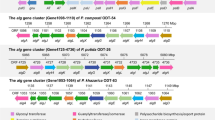Summary
R-prime plasmids were constructed from a derivative of Rhizobium strain NGR234 (ANU280) and were shown to contain overlapping genomic DNA segments involved in biosynthesis of exopolysaccharides (EPS). The R-primes originally constructed carried the mutant allele from Tn5-induced EPS-deficient (Exo−) mutant ANU2811. This plasmid-located mutant allele was dominant to the corresponding wild-type allele as merodiploid strains were Exo−. Exo+ revertants occurred at a low rate (1×10-7) and these were shown to result from double reciprocal recombination events, which led to the isolation of R-prime plasmids carrying functional wild-type exo alleles. R-prime plasmids that carry overlapping segments of DNA from parental strain ANU280 complemented 28 of the 30 group 2 Exo− mutants of strain ANU280. Complementation of these Exo− mutants also restored their symbiotic abilities of effective nodulation. Subsequent in vivo recombination between the wild-type alleles located on the R-prime and the corresponding mutated allele on the genome, was used to generate a new family of R-primes, which carried mutations in the exo genes. The 30 group 2 Exo− mutants were classified into 7 distinct genetic groups based upon complementation and physical mapping data. Five of the seven exo loci were gentically linked and located on a 15-kb region of DNA. Mutations at two loci were dominant only when the mutations were R-prime plasmid-located while a mutation at a second locus was cis-dominant to two other exo loci. At least five genes involved in the synthesis of acidic exopolysaccharide synthesis have been identified.
Similar content being viewed by others
References
Abe M, Sherwood JE, Hollingsworth RI, Dazzo FB (1984) Stimulation of clover root hair infection by lectin-binding oligosaccharides from the capsular and extracellular polysaccharides of Rhizobium trifolii. J Bacteriol 160:517–520
Banfalvi Z, Randhawa GS, Kondorosi E, Kiss A, Kondorosi A (1983) Construction and characterization of R-prime plasmids carrying symbiotic genes of R. meliloti. Mol Gen Genet 189:129–135
Bender GL, Rolfe BG (1985) A rapid plant assay for the Parasponia-Rhizobium symbiosis. Plant Sci Lett 19:277–284
Bolivar F, Rodriguez R, Greene PJ, Betlach M, Heyneker HL, Boyer HW, Crosa J, Falkow S (1977) Construction and characterization of new cloning vehicles II: a multipurpose cloning system. Gene 2:95–113
Chakravorty AK, Zurkowski W, Shine J, Rolfe BG (1982) Symbiotic nitrogen fixation: molecular cloning of Rhizobium genes involved in exopolysaccharide synthesis and effective nodulation. J Mol Appl Genet 1:585–596
Chen H, Batley M, Redmond JW, Rolfe BG (1985) Alteration of the effective nodulation properties of a fast-growing broad host-range Rhizobium due to changes in exopolysaccharide synthesis. J Plant Physiol 120:331–349
Dazzo FB, Brill WJ (1978) Bacterial polysaccharide which binds Rhizobium trifolii to clover root hairs. J Bacteriol 137:1362–1373
Djordjevic SP, Chen H, Batley M, Redmond JW, Rolfe BG (1987) Nitrogen-fixing ability of exopolysaccharide synthesis mutants of Rhizobium sp strains NGR234 and R. trifolii by the addition of homologous exopolysaccharide. J Bacteriol 169:53–60
Finan TM, Kunkel B, De Vos GF, Signer ER (1986) Second symbiotic megaplasmid in Rhizobium meliloti carrying exopolysaccharide and thiamine synthesis genes. J Bacteriol 167:66–72
Herskowitz I (1987) Functional inactivation of genes by dominant negative mutations. Nature 329:219–222
Leigh JA, Signer ER, Walker GC (1985) Exopolysaccharide-deficient mutants of Rhizobium meliloti that form ineffective nodules. Proc Natl Acad Sci USA 82:6231–6235
Maniatis T, Fritsch EF, Sambrook J (1982) Molecular cloning: a laboratory manual. Cold Spring Harbor Laboratory, Cold Spring Harbor, New York
Markovitz A (1977) Genetics and regulation of bacterial capsular polysaccharide biosynthesis and radiation sensitivity. In: Sutherland I (ed) Surface carbohydrates of the prokaryotic cell. Academic Press, London, pp 415–462
Nayudu M, Holloway BW (1981) Isolation and characterization of R-plasmid variants with enhanced chromosome mobilization ability in Escherichia coli K12. Plasmid 6:53–66
Nayudu M, Rolfe BG (1987) Analysis of R-primes demonstrates that broad host range genes of Rhizobium strain NGR234 are dispersed on the Sym plasmid. Mol Gen Genet 206:326–336
Plazinski J, Cen YH, Rolfe BG (1985) General method for the identification of plasmid species in fast-growing soil microorganisms. Appl Environ Microbiol 49:1001–1003
Rolfe BG, Gresshoff PM, Shine J (1980) Rapid screening for symbiotic mutants of Rhizobium and white clover. Plant Sci Lett 19:277–284
Scott KF, Rolfe BG, Shine J (1981) Biological nitrogen fixation: primary structure of the Klebsiella pneumoniae nifD genes. J Mol Appl Genet 1:71–81
Scott KF, Hughes JE, Gresshoff PM, Beringer LE, Rolfe BG, Shine J (1982) Molecular cloning of Rhizobium trifolii genes involved in symbiotic nitrogen fixation. J Mol Appl Genet 1:315–326
Simon R, Weber G, Arnold W, Puhler A (1981) Analysis of plasmid borne genes in Rhizobium meliloti, by Tn5 mutagenesis. In: Clark K, Stephens JHG (eds) Proc 8th Northen American Rhizobium Conference. University of Manitoba, Winnipeg, pp 67–89
Trinick MJ (1980) Relationships amongst the fast-growing rhizobia of Lablab purpureus, Leucaena leucocephala, Mimosa spp, Acacia farnesiana and Sesbania grandiflora and their affinities with other rhizobia groups. J Appl Bacteriol 49:39–53
Vieira J, Messing J (1982) The pUC plasmids, an M13mp7-derived system for insertion mutagenesis and sequencing with synthetic universal primers. Gene 19:259–268
Vincent JM (1980) Factors controlling the legume-Rhizobium symbiosis. In: Newton WE, Johnson WH (eds) Nitrogen Fixation, vol 2, University Park Press, Baltimore, pp 103–129
Willetts NS, Crowther C, Holloway BW (1981) The insertion sequence IS21 of R68.45 and the molecular basis for mobilization of the bacterial chromosome. Plasmid 6:30–52
Yannisch-Perron C, Vieira J, Messing J (1985) Improved M13 phage cloning vectors and host strains: nucleotide sequences of the M13mp18 and pUC19 vectors. Gene 33:103–119
Author information
Authors and Affiliations
Additional information
Communicated by J. Schell
Rights and permissions
About this article
Cite this article
Chen, H., Gray, J.X., Nayudu, M. et al. Five genetic loci involved in the synthesis of acidic exopolysaccharides are closely linked in the genome of Rhizobium sp strain NGR234. Mol Gen Genet 212, 310–316 (1988). https://doi.org/10.1007/BF00334701
Received:
Issue Date:
DOI: https://doi.org/10.1007/BF00334701




